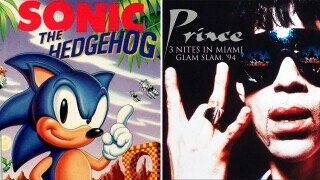Sonic's Greatest Soundtracks Were Ripped From Famous Pop Songs

Time to slip into your most festive red sneakers and put the candles on the chilidogs, Sonic the Hedgehog has just turned 30 years old. Sega is hosting a big anniversary bash to celebrate the old video game mascot, handing out free games. But, most exciting of all, the company has released a Sonic concert performed by the Prague Philharmonic Orchestra. 120 of the world’s greatest classically trained virtuosos used their million dollars-insured instruments and fingers to cover 16-bit blips and bloops meant to accompany a blue rodent doing loop-di-loops and jumping on robocrabs.
And for the record: Debussy or Handel have nothing on Green Hill Zone. Because if the Sonic franchise has one proud legacy (and it sure isn’t its pioneering work in 3D platforming, character design, or interspecies romance options), it’s the incredible music. Specifically, the soundtracks of Sonic The Hedgehog and Sonic The Hedgehog 2, composed by J-Pop legend Masato Nakamura. Over 14 heart-pounding tracks, Nakamura managed to revolutionize video game music, create several musical subgenres and inspire thousands of musicians from bedroom YouTubers to Lil Nas X. And he did all that with the help of nothing more than a rudimentary FM Yamaha sound chip and 16kb of audio RAM ... And Duran Duran ... And Prince.
As we’ve mentioned before, early video game music managed to get away with using tons of sampled songs without permission. But while most game composers tended to borrow sparingly and from obscure meatspace musicians (including Zelda lifting a riff from Deep Purple -- nobody who listens to all 12 minutes of April is sober enough to catch that one), Nakamura had a lot more brass. And I’m not just talking about him re-using the Big Ben bing bongs for the Sky Chase Zone.
Flipping through his eclectic record collection from his studio in London, Nakamura put elaborate replays (the preferred video game industry term for sampling) of other bands in over half of the Sonic tracks. And these weren’t random record store bargain bin EPs either. Every Sonic player has the tune of the Marble Hill Zone, the lava hell-level after the gentle meadows of the Green Hill Zone, burned into their mind. But what few ‘80s kids will realize is that its soothing sounds come from one of the biggest Easy Listening songs of the '60s, Music to Watch Girls By.
Similarly, if you were grateful for the cheerful grooves in the Labyrinth Zone in between the most terrifying drowning sound in any video game, you might want to send a thank-you note to The Emotions and their big R&B hit, Best of my Love.
And smooth grooves weren’t the only bass thumpers Nakamura wanted to use. For the Game Gear version of Sonic 2, battles with Dr. Robotnik had an extra edge as his dork-ass hoverball blasted the dirty techno beats of 808 State’s Cubik.
While the slightly macabre Mystic Cave Zone gets the full psycho treatment by replaying the high energy chaos of the Inspector Gadget theme song sprinkled with everyone’s least favorite haunted clown tune, Enter The Gladiators by Julius Fucik.
Yet these were just small fry compared to the big bands Nakamura let himself be inspired by for later levels. Reach the Final Zone in Sonic The Hedgehog, and not only are you rewarded with an intense battle to the death in Robotnik’s lair, but Sonic wind-blown hair gets to whip back and forth to the New Wave stylings of Duran Duran’s Planet Earth.
But the most brazen replay in the early Sonic canon has to be during the high tempo Chemical Plant Zone of Sonic 2, whose sickly greens and sterile greys seem downright sexy thanks to the bass riff of Glam Slam by Prince -- who must not have been too busy fighting over his own name to care about suing Sega.
So how did Nakamura and Sonic manage to keep outrunning the cease and desist lawsuits? (Really? You copied Prince? What, Disney isn’t litigious enough for you?) Maybe the appropriately gotta go fast double tempo of most of his replays threw off the copyright hounds. More likely was that Sega’s unique sound situation made it tricky to sue.
Instead of straight sampling (i.e., using the actual sound from a song), video games’ limited audio capabilities required artists to “interpolate” the music, where the artist had to reverse engineer the sound and play it themselves. Interpolation IP lawsuits are a lot less slam-dunk than audio sampling ones, especially if they’re brief and use different instruments. And since the Sega Genesis’ tricky sound chip required interpolation not just once but twice, first by Nakamura with a synth on cassette then by whatever poor programmer had to input by ear the tune into the complicated software, the odds of a clean-cut copyright payday were slim indeed.
After Sonic The Hedgehog 2, with no more lands to conquer, Nakamura retired from writing video game music. So for Sonic The Hedgehog 3, Sega decided to just cut out the middleman and hire a composer to steal from himself. That composer: Michael Jackson, whom Sega paid a small fortune just for him to quickly recycle half-finished versions of his upcoming songs and then pretended the collaboration never happened. It wasn’t better than Nakamura’s Sonic, but at least it was faster.
Cedric will never not sing the Bee Gees during the Starlight Zone. You can follow him on Twitter.
Top Image: Sega, Warner Bros. Records